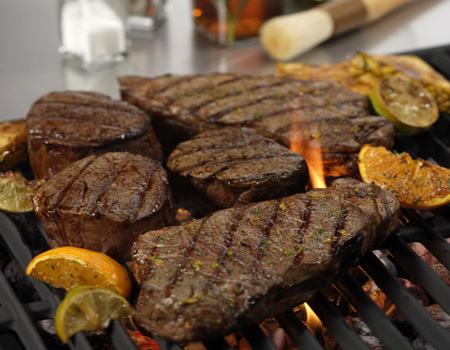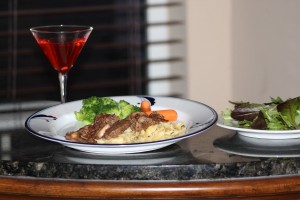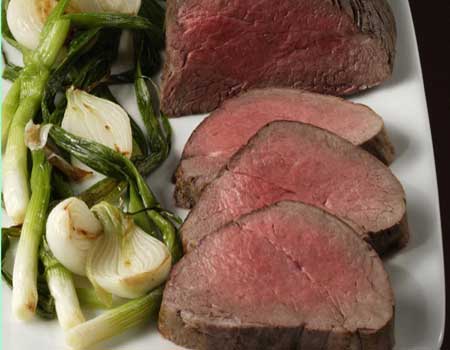
School is back in session so what better time to brush up on a lesson that is near and dear to my heart? Yes, class, it’s time for a lesson on steak.
Chef Sandy goes through the ins and outs of cuts for us here. And if you pay attention you might just get an extra recess.
I often get the question, “What kind of steak should I buy?”
- Well, that kind of depends on a few factors…
- What do you want to spend?
- What sort of texture do you want?
- What is the doneness level that you prefer?
- What kind of fat percentage do you want?
- What cooking method are you planning to use?
Here is a brief overview:
Many of the cuts of beef that are used for steaks are cut from the loin portion of the beef.
Most of us are well aware that filet mignon or beef tenderloin (and Chateaubriand) are all part of the same very expensive cut of beef. There is very little waste, very little work for the cook (little trimming is necessary) and it is appropriate for anything and anyone who likes steak, even at the fanciest meal. The texture of tenderloin is very tender, and some say that the flavor is not assertively beefy enough, but that is really a matter of choice.
Many times this cut of meat will be served with a sauce or an equally luxurious topping like a bleu cheese topping or it will be wrapped in bacon, all of which will enhance the flavor. This is the priciest cut of steak, but again, there is no waste, and not too much shrinkage, so what you buy (and pay for) is what you get to eat.
But what is the difference between a T-bone and a Porterhouse? How about a KC Strip and NY Strip?
A Porterhouse is a steak with a T-bone in the middle, and a large portion of both tenderloin and strip loin. A T-bone is the same steak, but the tenderloin portion is usually smaller than a silver dollar, or even non-existent. The bone-in nature of this steak usually yields great flavor, and oftentimes at the grocery store the T-bones actually have a large filet portion (and should therefore be labeled as the more expensive Porterhouse — shh, we won’t tell).
The difference between a KC Strip and a NY Strip is basically a marketing difference. Depends on where you are from. Either could come with a bone, but often not, and both are a generally oblong shaped steak, with not much visible marbling, but fat around the outside (non-bone side) of the meat. Depending on where you shop, and what part of the country you are from, these steaks are often in the high-middle of the price range for quick cooking steaks.
A ribeye or Delmonico steak is well marbled with fat, and because of its high fat content, can be cooked more well done and still remain juicy. This kind of steak will flame up on the grill, so it should definitely be watched carefully. One trick I have used is to first grill the steak on the grate to get grill marks (and flavor) and then put heavy duty foil on the grill and put the steaks on top to finish cooking them without incinerating them.
Sirloin steaks on the other hand, may need marinating to become juicy. They should not usually be cooked to more than medium doneness and oftentimes are sliced thinly against the grain for presentation to help ensure a tender dining experience. Flank steak and skirt steak (fajitas) are also cuts of meat which should be marinated, cooked quickly to a med-rare or medium doneness and sliced across the grain for tenderness.
Round steaks are usually too tough to use a direct cooking method, and are better suited to another preparation method like braising — think Swiss steak. Brown, then cook the steak until tender in flavor liquid (gravy) for a few hours. Many different cultures have variations on this theme, and a thin round steak can also be used as a wrapper for flavorful ingredients, with the whole bundle braised in flavorful liquid for a delicious meal. Italians call it Braciole (may also be made with flank steak) Germans have Rouladen. Long story short, braise it for great taste and tenderness.
If you are making Chicken Fried Steak, the traditional choice is a tenderized round steak. This is a piece of meat which has been put through a process which mechanically pounds the steak and breaks up the tissues with thousands of little blades. This is the only way to use this steak in a quick cooking manner, otherwise you would end up with shoeleather. I have seen Chicken Fried Ribeye and Chicken Fried Filet on some fancier menus here in Texas, and since these are more tender pieces of meat, no mechanical tenderizing is necessary. Tasty, and about as decadent as you can get…
If you have any questions about a piece of meat you are considering buying, just ask. At many grocery stores or even Web site, sometimes they have flip guides to cuts of meat and preferred cooking method, and sometimes even stickers on the actual meat packages which say “Great for the Grill” or “Best for Braising” or some similar catchy tips. Or better yet, try some new choices next time you go to your favorite steak restaurant, and make a note to yourself about what you like and the preparation methods you enjoy.
Then you can try them out at home!



